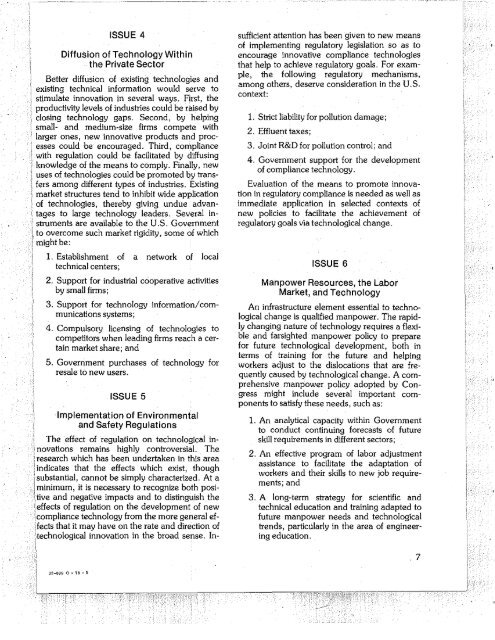Office of Technology Assessment - Bayhdolecentral
Office of Technology Assessment - Bayhdolecentral
Office of Technology Assessment - Bayhdolecentral
Create successful ePaper yourself
Turn your PDF publications into a flip-book with our unique Google optimized e-Paper software.
ISSUE 4<br />
Diffusion <strong>of</strong> <strong>Technology</strong> Within<br />
the Private Sector<br />
Better diffusion <strong>of</strong> existing technologies and<br />
existing technical information would serve to<br />
stimulate innovation in several ways. First, the<br />
productivity levels <strong>of</strong> industries could be raised by<br />
closing technology gaps. Second, by helping<br />
small- and medium-size firms compete with<br />
larger ones, new innovative products and processes<br />
could be encouraged. Third, compliance<br />
with regulation could be facilitated by diffusing<br />
knowledge <strong>of</strong> the means to comply. Finally, new<br />
uses <strong>of</strong> technologies could be promoted by transfers<br />
among different types <strong>of</strong> industries. Existing<br />
market structures tend to inhibit wide application<br />
<strong>of</strong> technologies, thereby giving undue advantages<br />
to large technology leaders. Several instruments<br />
are available to the U.S. Government<br />
to overcome such market rigidity, some <strong>of</strong> which<br />
might be:<br />
1. Establishment <strong>of</strong> a network <strong>of</strong> local<br />
technical centers;<br />
2. Support for industrial cooperative activities<br />
by small firms;<br />
3. Support for technology information/communications<br />
systems;<br />
4. Compulsory licensing <strong>of</strong> technologies to<br />
competitors when leading firms reach a certain<br />
market share; and<br />
5. Government purchases <strong>of</strong> technology for<br />
resale to new users.<br />
ISSUE 5<br />
Implementation <strong>of</strong> Environmental<br />
and Safety Regulations<br />
The effect <strong>of</strong> regulation on technological innovations<br />
remains highly controversial. The<br />
research which has been undertaken in this area<br />
indicates that the effects which exist, though<br />
substantial, cannot be simply characterized. At a<br />
minimum, it is necessary to recognize both posiand<br />
negative impacts and to distinguish the<br />
ieffects <strong>of</strong> regulation on the development <strong>of</strong> new<br />
lcompliance technology from the more general ef<br />
.fects that it may have on the rate and direction <strong>of</strong><br />
itechnological innovation in the broad sense. In-<br />
32-889 0 - 78 - 3<br />
sufficient attention has been given to new means<br />
<strong>of</strong> implementing regulatory legislation so as to<br />
encourage innovative compliance technologies<br />
that help to achieve regulatory goals. For example,<br />
the following regulatory mechanisms,<br />
among others, deserve consideration in the U.S.<br />
context:<br />
1. Strict liability for pollution damage;<br />
2. Effluent taxes;<br />
3. Joint R&D for pollution control; and<br />
4. Government support for the development<br />
<strong>of</strong> compliance technology.<br />
Evaluation <strong>of</strong> the means to promote innovation<br />
in regulatory compliance is needed as well as<br />
immediate application in selected contexts <strong>of</strong><br />
new policies to facilitate the achievement <strong>of</strong><br />
regulatory goals via technological change.<br />
ISSUE 6<br />
Manpower Resources, the Labor<br />
Market, and <strong>Technology</strong><br />
An infrastructure element essential to technological<br />
change is qualified manpower. The rapidly<br />
changing nature <strong>of</strong> technology requires a flexible<br />
and farsighted manpower policy to prepare<br />
for future technological development, both in<br />
terms <strong>of</strong> training for the future and helping<br />
workers adjust to the dislocations that are frequently<br />
caused by technological change. A comprehenslve<br />
manpower policy adopted by Congress<br />
might include several important components<br />
to satisfy these needs, such as:<br />
1. An analytical capacity within Government<br />
to conduct continuing forecasts <strong>of</strong> future<br />
skill requirements in different sectors;<br />
2. An effective program <strong>of</strong> labor adjustment<br />
assistance to facilitate the adaptation <strong>of</strong><br />
workers and their skills to new job requirements;<br />
and<br />
3. A long-term strategy for scientific and<br />
technical education and training adapted to<br />
future manpower needs and technological<br />
trends, particularly in the area <strong>of</strong> engineering<br />
education.<br />
7
















